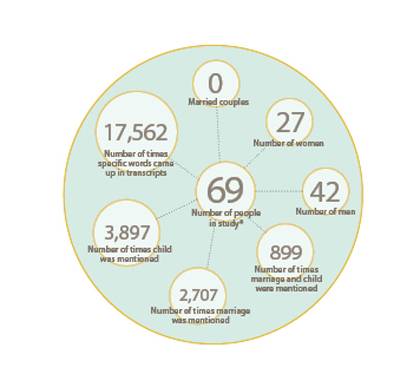
Heather Rackin's research focuses on an institution that profoundly shapes society -- the family. Concentrating on the family and fertility, she studies how inequality results in different family forms and explores links between marriage and fertility with a focus on how cognitive schemas and material conditions interact for low-income blacks.
Rackin, PARISS fellow and postdoc in the Department of Sociology, analyses hours of field interviews to encode the relationships between words in a text and construct a network of the linked words as a way to pull meaning out of text.
"If two words are in the same paragraph together, it probably means they are linked together cognitively. If one word brings up another, it means they are more closely connected in people's brain and are more likely to be associated. You let the computer do it for you. The hard part isn't the programming -- it's understanding what it all means," Rackin said.
As part of the PARISS Fellowship year-long program at SSRI, Rackin is part of an elite group of graduate students with an annual stipend, office space, computing, and other research and administrative support. All fellows are advanced graduate students working toward their dissertation, with interest and achievement in quantitative social science.
Rackin said the PARISS fellows program works so well because the group is cross-disciplinary. She said graduate students are most likely to try new things and push past the standard methodologies, but it can be difficult to get credibility, funding, and the support needed to pursue the research. Although the fellows are engaged in various research topics, they are able to share ideas, methodologies, and offer advice to one another.
"They understand what you're going through when you become frustrated or stuck on the research. We're all doing cool and innovative research and we're able to meet up and talk it out," Rackin said.
Rackin is trying to answer the question, "What are the ideas of low-income blacks before they have children and what kind of schemas do they have that surround children or marriage?"
Her research is important because in the current research there is a perception that the idea of marriage and child bearing are two disconnected decisions with different prerequisites. That has significant implications for policy. Contrary to previous findings that low-income parents do not link marriage and fertility and have different requirements for each, Rackin has found that marriage and childbearing are indeed linked and have similar requirements prior to childbearing.
Low-income blacks, she found, hold traditional views about the appropriate role of marriage and its sequencing vis-à-vis fertility. She argues that the material constraints to marital childbearing may lead to non-marital births and therefore respondents sever schemas connecting marriage and childbearing and adopt other schemas of childbearing to provide ad hoc justifications for their behavior. Much of the previous research was conducted on unwed parents.
"It's hard to say that what we find in low-income unwed parents applies globally to low-income individuals and communities. Aspirations for middle class are ideal, but being able to get it is a different story. And if you can't get it, you may change the way you think about things," Rackin said.
Rackin has always been interested in families. As an undergraduate she conducted an evolutionary biology thesis on fertility patterns and sexuality in monkeys. When she arrived at Duke she was able to collaborate with faculty working on similar research projects including S. Philip Morgan, former director of SSRI, and Christina Gibson-Davis, associate professor of public policy. Much of the data she uses is from Gibson Davis' project.
After learning more about Jim Moody's methodologies on social networks, she became interested in the network research. She has learned how to adapt Moody's methodologies for words, instead of the more traditional data, to better understand how people's cognition influences their behavior.
Rackin's ultimate goal is to mesh quantitative and qualitative analysis to create a hybrid that includes the strengths of both methodologies. She she she hopes she can help bridge the qualitative/quantitative divide while enlarging and transforming the scope of possible answerable questions.